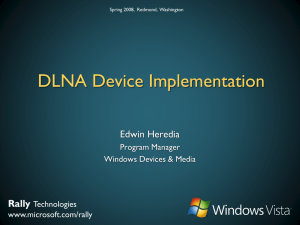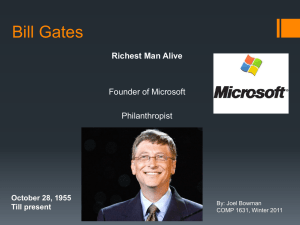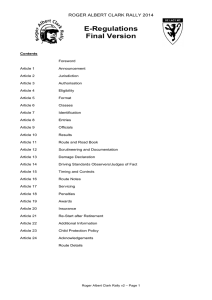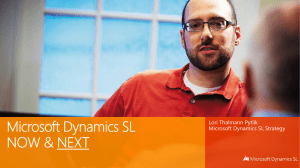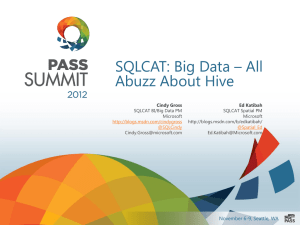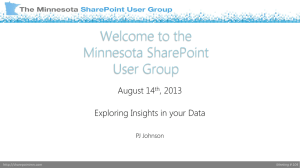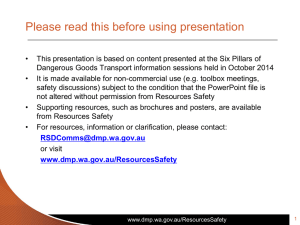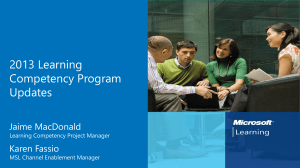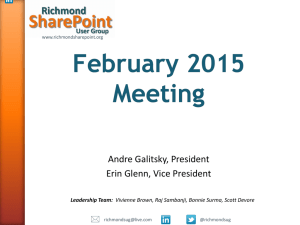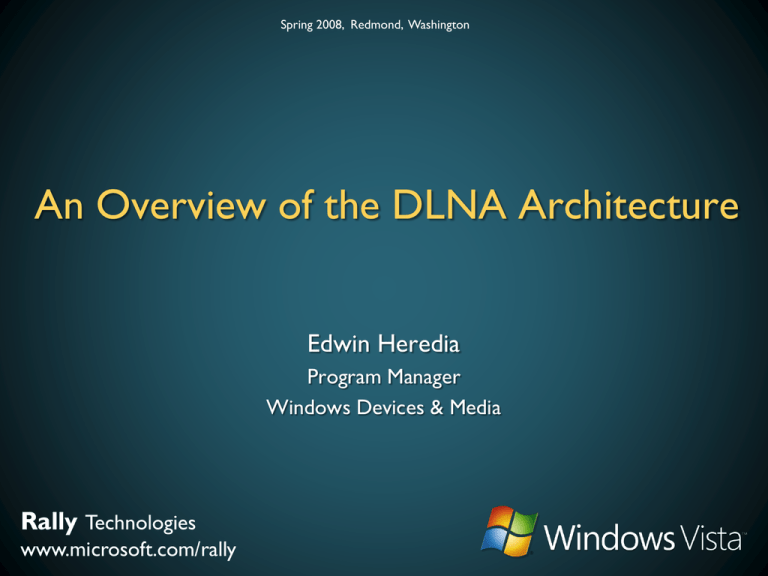
Spring 2008, Redmond, Washington
An Overview of the DLNA Architecture
Edwin Heredia
Program Manager
Windows Devices & Media
Rally Technologies
www.microsoft.com/rally
Industry consortium
250+ companies
Consumer Electronics
Computing Industry
Mobile Devices
Content distributors
Promoters
Introduction to DLNA
Goal: Establish an ecosystem of
compatible products for networked media
devices
Develops standards-based specifications:
“DLNA Guidelines”
Rally Technologies
www.microsoft.com/rally
DLNA versions
Version 1.0
Guidelines published in 2005
Cert program available in 2006
2000+ certified devices
Expanded Guidelines (commonly known as V1.5)
Guidelines published in Oct 2006
Partial cert program started in Q4 of 2007
Additional cert options available in Q3 of 2008
60+ certified devices
Additional Expanded Guidelines (commonly known as V2.0)
Ongoing work towards publication of additional Guidelines
Rally Technologies
www.microsoft.com/rally
Scope of DLNA versions
Version 1.0
2 volumes: Architecture & Protocols, Media Formats
2 Device Classes: DMP, DMS
About 50 media format profiles
Version 1.5
3 volumes: Architecture & Protocols, Media Formats, and Link Protection
12 Devices Classes and 5 Device Capabilities
About 250 media format profiles
Version 2.0
Not yet finalized; includes topics like EPG, Content Sync, RUI, WPS, Media
Formats, Scheduled recording, DRM
Rally Technologies
www.microsoft.com/rally
UPnP Device Architecture
Controllers
Devices
Discovery
NOTIFY messages (presence announcements)
SSDP
M-SEARCH messages (device/service search)
Description
SSDP
GET device & service description
Control
XML
Events
SOAP
GENA
GENA
Rally Technologies
www.microsoft.com/rally
UPnP Actions
Event subscriptions
Event notifications
UPnP Media Devices
Devices
UPnP
MediaServer
Controllers
MediaServer CP
UPnP Control Point
UPnP
MediaRenderer
Rally Technologies
www.microsoft.com/rally
MediaRenderer CP
2-box push
2-box pull
DLNA 2-Box Models
1. Get Media Library info
3. Get Content stream
1. Get Media Library info
and select content
2. Pass URI for selected content
3. Get Content binary stream
Rally Technologies
www.microsoft.com/rally
2. Select
content
DLNA 3-Box Model
2. Select
content
1. Get Media Library info
3. Pass URI & metadata for
selected content
4. Get Content binary stream
Rally Technologies
www.microsoft.com/rally
Device Classes & Capabilities
A Device Class is a “certifiable unit”
Company X implements a Device Class and goes to DLNA
requesting certification
A Device Capability is an “interesting component”
that can be added to some Device Classes for
increased functionality
DLNA does not certify Device Capabilities
Rally Technologies
www.microsoft.com/rally
Device Classes
Category: Home Networked Devices (HND)
Category: Mobile Handheld Devices (MHD)
Digital Media Server (DMS)
Mobile Digital Media Server (M-DMS)
Digital Media Player (DMP)
Mobile Digital Media Player (M-DMP)
Digital Media Renderer (DMR)
Digital Media Controller (DMC)
Mobile Digital Media Controller (M-DMC)
Digital Media Printer (DMPr)
Mobile Digital Media Uploader (M-DMU)
Mobile Digital Media Downloader (M-DMD)
Category: Networked Infrastructure Devices (NID)
Media Interoperability Unit (MIU)
Mobile Network Connectivity Function (M-NCF)
Rally Technologies
www.microsoft.com/rally
Device Capabilities
Interacts with…
Upload Controller (+UP+)
DMS with upload support
Download Controller (+DN+)
DMS with download support
Push Controller (+PU+)
DMR
Printing Controller 1 (+PR1+)
DMPr
Printing Controller 2 (+PR2+)
DMPr
Rally Technologies
www.microsoft.com/rally
2-box push
2-box pull
DLNA 2-Box Models Revisited
2. Select
content
1. Get Media Library info
DMS
3. Get Content stream
DMP
1. Get Media Library info
and select content
2. Pass URI for selected content
+PU+
with
Device
Class
Rally Technologies
www.microsoft.com/rally
3. Get Content binary stream
DMR
DLNA 3-Box Model Revisited
2. Select
content
1. Get Media Library info
DMC
3. Pass URI & metadata for
selected content
DMS
4. Get Content binary stream
DMR
Rally Technologies
www.microsoft.com/rally
DMPs and DMRs
UPnP
MR
Media
Decoding
UPnP
MSCP
Media
Decoding
UPnP
MR
UPnP
MRCP
HTTP
HTTP
HTTP
TCP/IP
TCP/IP
TCP/IP
Phy Layer
Phy Layer
Phy Layer
DMR
DMP
Media
Decoding
DMR and DMP
• DMCs, M-DMCs, DMPs derive from the UPnP Controller class
• UPnP Controllers do not implement Device Discovery . They cannot be discovered
via UPnP protocols. They can be discovered only at lower layers (TCP/IP)
• WMP11 for example discovers a DMP’s MAC address but it does not know its name,
manufacturer, and cannot present an icon (the DMP shows as ‘unknown device’)
• A dual DMP/DMR device provides the best of both usage scenarios (push and pull)
Rally Technologies
www.microsoft.com/rally
Media Formats
The term “Format” is equivalent to “codec” or “codec family”
List of DLNA-approved formats:
Video
MPEG-1
MPEG-2
H.263
MPEG-4 Part 2
MPEG-4 Part 10
WMV9
VC-1
Rally Technologies
www.microsoft.com/rally
Audio
LPCM
MPEG-1/2 L2
MPEG-1/2 L3
MPEG-4 AAC LC
MPEG-4 AAC LTP
MPEG-4 HE AAC
MPEH-4 BSAC
AC-3
ATRAC3plus
WMA
WMA Professional
AMR
AMR-WB+
G.726
Images
JPEG
PNG
GIF
TIFF
Media Format Profiles
The term “Profile” represents a combination of encoding
formats used to create media objects
Examples:
MPEG_PS_NTSC
Video: MPEG-2 (NTSC constraints)
Audio: Encoded using either AC-3, LPCM, or MPEG 1/2 L2
System: Program Streams
Other constraints: Follows DVD-RW specifications
WMVHIGH_FULL
Video: WMV Main Profile at High Level
Audio: WMA using full bit rate (385 Kbps)
Encapsulation: ASF
Rally Technologies
www.microsoft.com/rally
Media Format Interoperability
DLNA has defined so far more than 350 profiles!
Obviously, devices can’t support 350 profiles. The word
“support” here means:
Servers have to expose the object with its Profile ID and stream its
content
Receivers (DMRs, DMPs) have to decode and render the object
Consequently DLNA defines Required Profiles depending on:
The Media Class (Images, Audio, Audiovisual)
The Device Category (Home, Mobile)
The Geographical Region (US, EU, Japan, Korea)
Rally Technologies
www.microsoft.com/rally
DLNA Required Profiles
Image
Home
(HND)
Audio
JPEG_SM
LPCM
JPEG_SM
Server must expose
content with at least ONE
of these profiles:
Receivers must decode and
render content inALL of
these profiles:
Mobile
(MHD)
A/V
See next slide
AVC_MP4_BL_CIF15_AAC_520
AAC_ISO_320
MP3
For certification devices select the Home, Mobile or both categories
For certification devices select the Image, Audio, A/V, or any combinations
Rally Technologies
www.microsoft.com/rally
Required A/V Profiles (HND)
Servers must be capable of exposing
content with at least ONE of these
profiles
Receivers must decode and render content in
ALL of these profiles
US
MPEG_TS_SD_NA , MPEG_TS_SD_NA_T , MPEG_TS_SD_NA_ISO,
MPEG_PS_NTSC
Japan
MPEG_TS_JP_T , MPEG_PS_NTSC
Europe MPEG_TS_SD_EU, MPEG_TS_SD_EU_T, MPEG_TS_SD_EU_ISO, MPEG_PS_PAL
Korea
MPEG_TS_SD_KO, MPEG_TS_SD_KO_T , MPEG_TS_SD_KO_ISO,
MPEG_PS_NTSC
For certification devices select one or more regions
Rally Technologies
www.microsoft.com/rally
Windows Media Profiles
DLNA Profile ID
Audio
Video
WMVMED_BASE
WMA; bit rate < 193 Kbps
WMV Main Profile @ Medium Level
WMVMED_FULL
WMA; full bit rate (385 Kbps)
WMV Main Profile @ Medium Level
WMVHIGH_FULL
WMA; full bit rate (385 Kbps)
WMV Main Profile @ High Level
WMVSPLL_BASE
WMA; bit rate < 193 Kbps
WMV Simple Profile @ Low Level
WMVSPML_BASE
WMA; bit rate < 193 Kbps
WMV Simple Profile @ Medium Level
WMABASE
WMA; bit rate < 193 Kbps
N/A
WMAFULL
WMA; full bit rate (385 Kbps)
N/A
There are other WMA, WMV, and VC-1 profiles in DLNA but the ones listed here constitute the
fundamental core for Windows Networking Media Devices
Rally Technologies
www.microsoft.com/rally
Next
In the next session we will cover:
Implementation details of DMS, DMR, DMC
The DLNA device certification process
Thanks!
Rally Technologies
www.microsoft.com/rally
Spring 2008, Redmond, Washington
© 2006 Microsoft Corporation. All rights reserved. Microsoft, Windows, Windows Vista and other product names are or may be registered trademarks and/or trademarks in the U.S. and/or other countries.
The information herein is for informational purposes only and represents the current view of Microsoft Corporation as of the date of this presentation. Because Microsoft must respond to changing market conditions, it should
not be interpreted to be a commitment on the part of Microsoft, and Microsoft cannot guarantee the accuracy of any information provided after the date of this presentation.
MICROSOFT MAKES NO WARRANTIES, EXPRESS, IMPLIED OR STATUTORY, AS TO THE INFORMATION IN THIS PRESENTATION.
Rally Technologies
www.microsoft.com/rally

